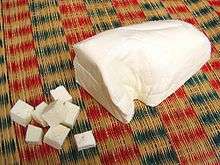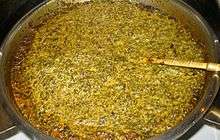Paneer
 Paneer | |
| Alternative names | Chhana, chhena |
|---|---|
| Type | Cheese |
| Place of origin | Indian Subcontinent |
| Main ingredients | Strained curdled milk |
| Other information | Rich source of milk protein |
|
| |
Paneer (pronounced [pəniːr]) is a fresh cheese common in South Asia, especially in Indian, Pakistani, Afghan, Nepali, and Bangladeshi cuisines. It is an unaged, acid-set, non-melting farmer cheese or curd cheese made by curdling heated milk with lemon juice, vinegar, or any other food acids. Its crumbly and moist form is called chhena in eastern India and in Bangladesh.
Etymology and history
The word "paneer" is of Persian origin.[1] The Turkish word peynir, the Persian word panir, the Azerbaijani word panir, and the Armenian word panir (պանիր), all derived from "paneer", refers to any type of cheese.[2] The origin of paneer itself is debated. Vedic Indian, Afghan-Iranian and Portuguese-Bengali origins have been proposed for paneer.[3][4]
Vedic literature refers to a substance that is interpreted by some authors, such as Sanjeev Kapoor, as a form of paneer.[3] According to Arthur Berriedale Keith, a kind of cheese is "perhaps referred to" in Rigveda 6.48.18.[5] However, Otto Schrader believes that the Rigveda only mentions "a skin of sour milk, not cheese in the proper sense".[6] K. T. Achaya mentions that acidulation of milk was a taboo in the ancient Indo-Aryan culture, pointing out that the legends about Krishna make several references to milk, butter, ghee and yogurt, but do not mention sour milk cheese.[7]
Based on texts such as Charaka Samhita, BN Mathur wrote that the earliest evidence of a heat-acid coagulated milk product in India can be traced to 75-300 CE, in the Kushan-Satavahana era.[8] Sunil Kumar etal. interpret this product as the present-day paneer. According to them, paneer is indigenous to north-western part of South Asia, and was introduced in India by Afghan and Iranian travelers.[9] D.R. Ghodekar of India's National Dairy Research Institute also believed that paneer was introduced into India by Afghan and Iranian invaders.[10]
According to writers such as K.T. Achaya, Andrea S. Wiley and Pat Chapman, the Portuguese introduced the technique of "breaking" milk with acid to Bengal in the 17th century. Thus, Indian acid-set cheeses such as paneer and chhena were first prepared in Bengal, under Portuguese influence.[7][11][12]
Preparation
| Nutritional value per 183 g | |
|---|---|
| Energy | 182 kJ (43 kcal) |
|
10 g | |
| Sugars | 10 g |
|
2 g | |
|
7 g | |
| Vitamins | |
| Vitamin A equiv. |
(6%) 44 μg |
| Minerals | |
| Calcium |
(23%) 230 mg |
| Iron |
(0%) 0 mg |
| Sodium |
(6%) 87 mg |
| |
|
Percentages are roughly approximated using US recommendations for adults. Source: nutritiondata.com | |
Paneer is prepared by adding food acid, such as lemon juice, vinegar, citric acid or yogurt,[13] to hot milk to separate the curds from the whey. The curds are drained in muslin or cheesecloth and the excess water is pressed out. The resulting paneer is dipped in chilled water for 2–3 hours to improve its texture and appearance. From this point, the preparation of paneer diverges based on its use and regional tradition.
In most Nepalese cuisines, the curds are wrapped in cloth, placed under a heavy weight such as a stone slab for two to three hours, and then cut into cubes for use in curries. Pressing for a shorter time (approximately 20 minutes) results in a softer, fluffier cheese.
In Bengali and other east Indian cuisines, the curds are beaten or kneaded by hand into a dough-like consistency, resulting in chhena (also known as sana or chhana). In these regions, chhena is distinguished from paneer (called ponir), a salty semi-hard cheese with a sharper flavor and high salt content. Hard ponir is typically eaten in slices at teatime with biscuits or various types of bread, or deep-fried in a light batter.
In the area surrounding the Gujarati city of Surat, Surti Paneer is made by draining the curds and ripening them in whey for 12 to 36 hours.
Use in dishes


Paneer is the most common type of cheese used in traditional Indian and Pakistani cuisines. The use of paneer is more common in India, Nepal, Bangladesh and Pakistan. It is sometimes wrapped in dough and deep-fried or served with either spinach (palak paneer) or peas (mattar paneer).
The well-known rasgulla features plain chhana beaten by hand and shaped into balls which are boiled in syrup. The sana / chhana / chhena used in such cases is manufactured by a slightly different procedure from paneer; it is drained but not pressed, so that some moisture is retained, which makes for a soft, malleable consistency. It may, however, be pressed slightly into small cubes and curried to form a dalna in Maithili, Oriya and Bengali cuisines.
Paneer dishes
Some paneer dishes include:
- Sandesh
- Chhena murgi
- Mattar paneer (paneer with peas)
- Saag paneer
- Shahi paneer (paneer cooked in a rich, Mughlai curry)
- Paneer tikka (a vegetarian version of chicken tikka, paneer placed on skewers and roasted)
- Paneer tikka masala
- Kadai paneer
- Chili paneer (with spicy chilies, onions and green peppers, usually served dry and garnished with spring onions)
- Paneer pakora (paneer fritters)
- Palak paneer
- Rasmalai
- Rasgulla
- Paneer capsicum (paneer and bell peppers in raisin crème sauce)
- Khoya paneer
- Paneer bhurji
- Paneer momo (dumpling)
Fast food

Most international fast food restaurants in India offer paneer. McDonalds India serves the McSpicy Paneer[14] and Paneer Wrap.[15] In the United Kingdom, Subway has started serving a saag paneer patty. The Tamatanga urban Indian cuisine restaurant also serves a paneer wrap.[16] Taco Bell India serves a paneer and potato burrito.[17] Pizza Hut,[18] Domino's,[19] and Papa John's[20] have pizzas with paneer toppings.
Similar cheeses
Anari, a fresh mild whey cheese produced in Cyprus, is very similar in taste and texture to fresh Indian paneer.
Circassian cheese is produced using a similar method and is close in consistency to paneer, but is usually salted.
Farmer cheese, dry curd cottage cheese, and firm versions of quark are similar except that they are made from cultured milk and may be salted.
Queso blanco or queso fresco are often recommended as substitutes in the Americas as they are more commercially available in many American markets. Both are generally salted, unlike paneer.
References
- ↑ The Indian Historical Quarterly, Volume 2, Issues 1-2. Ramanand Vidya Bhawan. 1985. p. 236.
- ↑ Davidson, Alan (2006). Jaine, Tom, ed. The Oxford Companion to Food (2 ed.). Oxford: OUP Oxford. ISBN 978-0191018251.
panir and peynir, the Farsi (Persian) and Turkish words for 'cheese' (...)
- 1 2 Sanjeev Kapoor (2010). Paneer. Popular Prakashan. p. 3. ISBN 9788179913307.
- ↑ Timothy G. Roufs and Kathleen Smyth Roufs (2014). Sweet Treats around the World: An Encyclopedia of Food and Culture. ABC-CLIO. p. 168. ISBN 9781610692212.
- ↑ Arthur Berriedale Keith (1995). Vedic Index of Names and Subjects. Motilal Banarsidass. p. 209. ISBN 9788120813328.
- ↑ Otto Schrader (1890). Prehistoric Antiquities of the Aryan Peoples. C. Griffin. p. 319.
- 1 2 Harlan Walker, ed. (2000). Milk - Beyond the Dairy: Proceedings of the Oxford Symposium on Food and Cookery 1999. Oxford Symposium. pp. 53–57. ISBN 9781903018064.
- ↑ Indian Journal of Dairy Science, Volume 45. Indian Dairy Science Association. 1992. p. 281.
- ↑ Kumar, Sunil; Rai, D.C.; Niranjan, K.; Bhat, Zuhaib (2011). "Paneer—An Indian soft cheese variant: a review". Journal of Food Science & Technology. Springer. 51 (5): 821–831. doi:10.1007/s13197-011-0567-x. PMC 4008736
 . PMID 24803688.
. PMID 24803688. People during the Kusana and Saka Satavahana periods (AD75–300) used to consume a solid mass, whose description seems to the earliest reference to the present day paneer
- ↑ R. K. Robinson and A. Y. Tamime (1996). Feta & Related Cheeses. CRC Press. p. 231. ISBN 9780747600770.
- ↑ Pat Chapman (2009). India Food and Cooking: The Ultimate Book on Indian Cuisine. New Holland. p. 33. ISBN 9781845376192.
- ↑ Andrea S. Wiley (2014). Cultures of Milk. Harvard University Press. p. 2. ISBN 9780674369702.
- ↑ Adiraja Dasa. The Hare Krishna book of Vegetarian Cooking. Bhaktivedanta Book Trust, 1989, ISBN 0-902677-07-1
- ↑ "McDonald's launches McSpicy products". The Hindu. April 3, 2011.
- ↑ http://www.mcdonaldsindia.com/pdf/McSpicy-press-release-final.pdf
- ↑ Mitra, Kushan (June 12, 2011). "Say (Cottage) Cheese: McDonalds paneer burger for the Indian palate". businesstoday.intoday.in. Retrieved July 1, 2011.
- ↑ Place, Investor (March 30, 2011). "Taco Bell paneer and potato burritos are a hit". MSN. Retrieved July 1, 2011.
- ↑ "Pizza Hut India menu".
- ↑ "Dominos Peppy Paneer Pizza".
- ↑ "Papa Johns Pizza India menu".